Boyan, a Han culture association in Paris, has dedicated over a decade to promoting Chinese culture in France, yet it still faces challenges due to funding issues.
With five days until the Mid-Autumn Festival — a Chinese celebration of the full moon and family reunion — a Carrefour supermarket in the northern suburbs of Paris was alive with festive decor. Shelves were stocked with a variety of mooncakes, the festival’s signature pastries, while nearby posters featuring moon motifs, sky lanterns, and symbols of togetherness added to the holiday spirit.
Xie Sijia and her two teammates had already been waiting by a poster for nearly two hours, fully dressed in elaborate costumes — their hair accessories and makeup perfectly matching the green and crimson hues of their Hanfu, an umbrella term for traditional or traditionally inspired Chinese clothing. The Hanfu Xie and her colleagues wore mimic the attire of the feitian (Flying Goddess) whose image discovered on the wall paintings at Dunhuang.
However, there wasn’t much for them to do. Carrefour’s French executives were running late, so after one final run-through of their dance moves, the trio quietly took their positions on stage, waiting for the performance to begin.
Xie, the captain of Association Boyan's dance team, and her two teammates were invited to perform as a warm-up act for a Mid-Autumn Festival promotional event aimed at the local Asian community. Meanwhile, the association's president, Zhong Yueru, was tasked with recording the entire performance, capturing photos for a prompt update on the association's social media.
This year marks Zhong's 17th year in France. A decade ago, she founded Boyan as a non-profit cultural organization, dedicated to promoting Chinese culture in France.
Over the past ten years, Boyan has grown into the largest cultural organization of its kind in Paris, with nearly 500 members. Surprisingly, despite being a Chinese culture association, the participants aren’t limited to Chinese or people of Chinese descent—around 30% of its members are French.
Xie and her team’s performance was set to music from a traditional poem celebrating the Lantern Festival, a Chinese holiday marking the first full moon after the Lunar New Year. The music felt out of season, but the dancers moved gracefully, and the stage, surrounded by posters in French, English, Chinese, and Vietnamese, served as a cultural bridge, reimagining the Mid-Autumn Festival through a distinctly French lens.
Xie hesitated during the final move, showing a brief flash of embarrassment. Afterward, still frustrated, she said, "The floor was so slippery that I couldn’t get it right."
However, the audience—Carrefour executives and vendors—didn’t seem to mind, offering polite applause as the dancers left the stage to the suited businesspeople.
The team retreated to a cluttered staff office, eating their delayed lunch of cold Vietnamese spring rolls from paper plates. Zhong arrived afterward with a suitcase of Hanfu carefully selected for other staff members to try on for the occasion. She had eaten outside, pairing her spring rolls with a glass of red wine while networking and eyeing potential business deals.
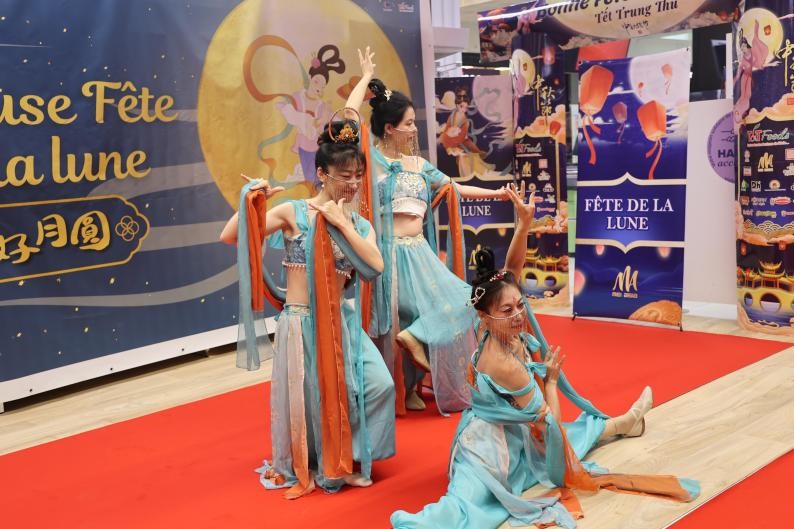
Boyan’s dance team is performing at a Carrefour supermarket in the northern suburbs of Paris
From a seafood restaurant to UNESCO
Zhong, originally from Sichuan, came to France for a dual master’s program and later completed her PhD, ultimately staying to work. While in France, she discovered a passion for Hanfu and met a group of like-minded friends who shared her love for traditional Chinese culture at a student gathering.
"The origins of Boyan date back to 2008 when it was just a small online group of a few dozen people,” Zhong recalled. "By 2014, as I was finishing my PhD, I decided to officially register it as an association.” According to Zhong, the membership quickly grew to over 100 in the first year, and the expansion has continued rapidly since then.
Built on the foundation of Hanfu, Boyan has grown into France's largest Han culture association over the past decade. It is organized into seven divisions, encompassing traditional music, chess, painting, tea, and incense ceremonies.
The dance troupe is part of the Music Division, where all members can learn Chinese classical dance in Hanfu, with the most skilled dancers joining the performance team for events and commercial shows. These performances not only enhance the association’s visibility but also generate essential funds, though often just enough to get by.
In addition to large commercial venues like Carrefour, Boyan has performed throughout Paris. "Once, we were set to dance in a seafood restaurant, but the area by the fish tank was too small, so we ended up performing on the sidewalk outside,” Xie said.
With each event, Boyan has steadily grown, especially after the pandemic, receiving collaboration invitations from the government, businesses, and other organizations.
During the Paris Olympics, major Chinese brands like Yili, Mengniu, and Chagee invited Boyan to participate in their events. Last year, the association was the only group invited to present a Hanfu fashion show at United Nations Educational, Scientific and Cultural Organization (UNESCO), headlining the 35th anniversary of the Silk Roads programme..
This year, to mark the 60th anniversary of diplomatic ties between China and France, Boyan gifted Jérôme Coumet, the mayor of Paris’s 13th arrondissement, a custom silk Hanfu in the red, white, and blue of the French flag, thanking him for his ongoing support of the Chinese community.
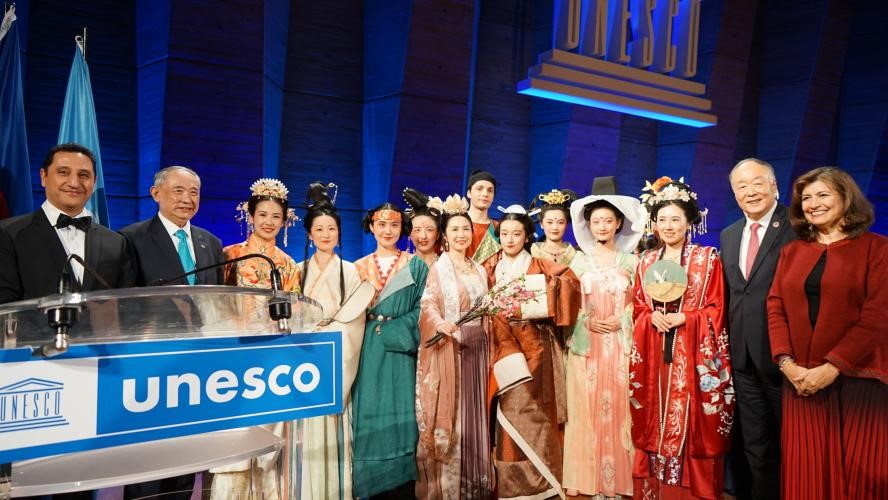
The Hanfu fashion show on the UNESCO stage
Zhong said Coumet really liked this Hanfu, "He wore the Hanfu to many events and later even submitted it to a newspaper. It unexpectedly became one of the ‘100 significant items’ commemorating the 60th anniversary of diplomatic relations between China and France.”
Zhong has experienced many such proud moments, but she knows it’s the relentless perseverance during the quieter, even more challenging times that truly fuels Boyan’s success.
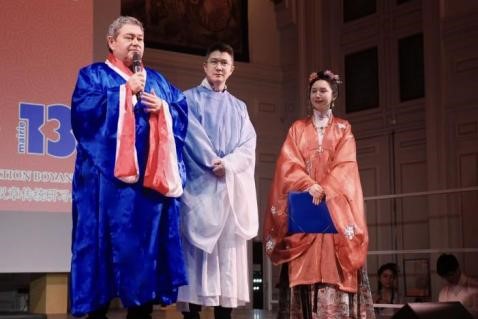
The silk Hanfu in red, white, and blue, inspired by the French flag, presented to Jérôme Coumet
Embracing Chinese Traditions Among French Communities
At the Carrefour event, Boyan also provided Hanfu for the supermarket staff, adding to the festive atmosphere. One staff member, a young woman from Argentina who stayed in France after her studies, shared her excitement. When someone asked her about the feeling of wearing Hanfu, she said she felt lucky to try "a tiny piece” of Chinese culture.
Indeed, just a quick taste of a tiny piece.
This reflects how many approach foreign cultures—polite but somewhat detached. Yet for Zhong, even a small taste is an opportunity. Chinese culture is vast, and even a small taste can leave a lasting impact.
Apart from the unique charm of Chinese culture, She also attributes Boyan’s success to France’s inclusiveness and diversity, which allows them the freedom to showcase Chinese traditions.
"For example, today, before the performance, I took my daughter to school while already dressed in my dance costume, with the Hanfu for the show underneath and my traditional hairstyle done,” Xie said. "I took the metro and bus, making several transfers, and felt completely at ease.”
"It’s like how many African women in France wear their traditional robes. No one criticizes them for it; everyone is free and unashamed,” she said.
What’s even more delightful, Xie added, is that they often receive compliments when wearing Hanfu in public. "People often tell us we look beautiful on the street, and sometimes on the bus, they even offer us their seats, which makes us feel respected.”
Zhong noted that Hanfu wearers are sometimes mistaken for Japanese. To clear this up, Boyan members printed stickers reading "Chinese Hanfu” in French to give to curious passersby. "The French are very respectful,” Zhong explained. "Once they know it’s Chinese Hanfu, they correct themselves right away. It (the mislabeling) is not intentional; they just didn’t know.”
The French have shown remarkable enthusiasm for traditional Chinese culture. According to Zhong, large public events organized by Boyan, like the annual Shangsi Festival, attract between 800 and 2,000 attendees per hour, many of whom are French.
The Shangsi Festival, traditionally celebrated on the third day of the third month of the Chinese lunar calendar, originated from ancient Chinese spring outings and river bathing intended for health and well-being. At this year's Shangsi Festival outing hosted by Boyan, about 40% of the participants were foreigners. Chinese and international attendees, dressed in Hanfu, sat along both sides of a 30-meter tea table and took part in a series of traditional festival activities.
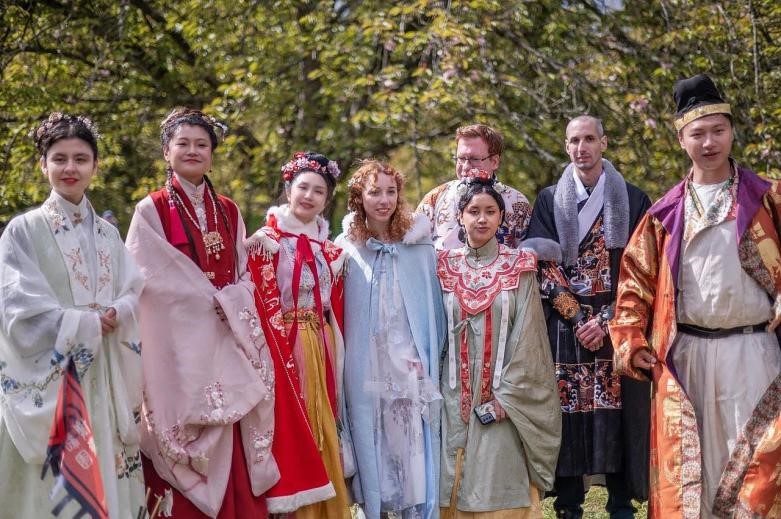
The Shangsi Festival attracts local residents.
The association has also attracted many French people, especially the middle-aged and the elderly, who are interested in Chinese culture. We have a lot of members in their 50s and 60s because they have more free time, said Zhong. "Once they develop an interest, they’re incredibly committed, often more so than us.”
Zhong shared an example from the tea class, noting how diligent the French students are. She explained that they meticulously document each tea tasting, recording details like the color and temperature of each brew.
Some older members, unfamiliar with computers, would handwrite their notes and ask their children to type them into Word documents, even printing them out with pictures. They carefully labeled each infusion, detailing the grams of tea used and the tea’s color.
"Some French students take their tea documentation a step further,” she said. "They use their phones to photograph each brew and add detailed notes on the color and flavor.”
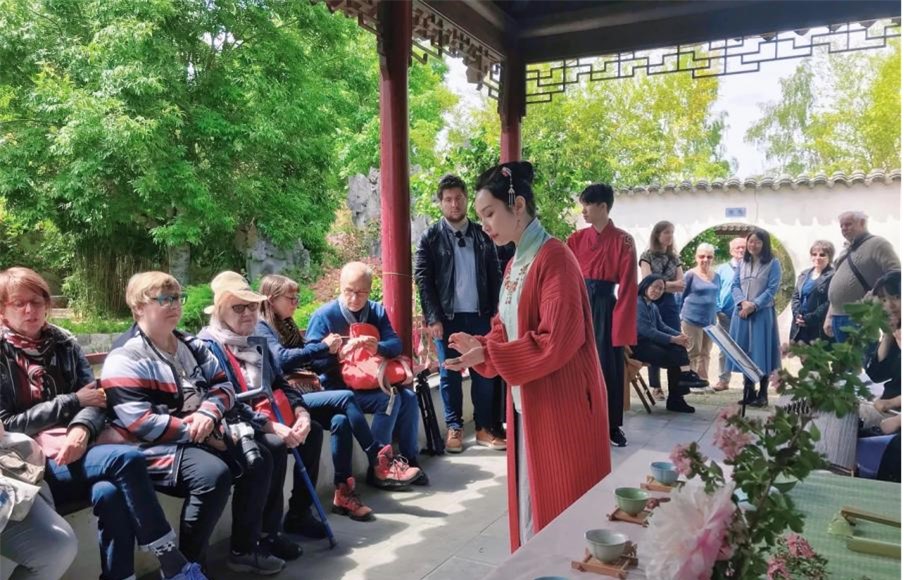
Boyan promotes Chinese tea culture in France
In contrast, Zhong observed that Chinese students often forgot their assignments and could only vaguely recall how the tea had been brewed in the previous session.
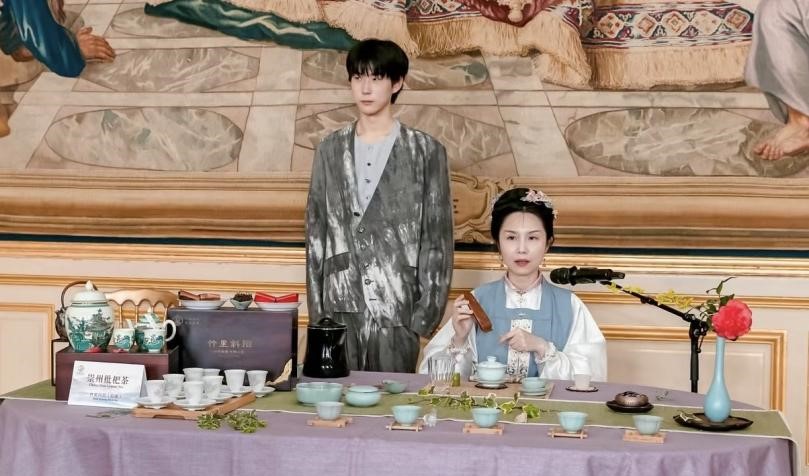
Zhong is teaching a tea class
Philippe Tonnerre, a 62-year-old tea enthusiast, stands out among the tea students. Forced into early retirement due to health issues, Philippe felt aimless and bored—until a chance encounter changed everything.
At a Chinese cultural exhibition, he met Boyan members demonstrating Kung fu tea, a traditional Chinese tea ceremony focused on precise brewing techniques. This sparked a deep passion for Chinese tea culture. Though Philippe had been part of a French tea association before, his experience with Boyan ignited a new, unwavering dedication to exploring Chinese tea traditions.
Since joining Boyan, Philippe said his life has become much more fulfilling. No longer stuck in a monotonous routine, he now finds joy in learning tea arts and taking part in the association’s various cultural events.
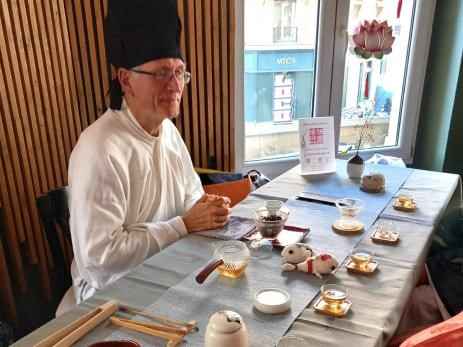
Philippe is studying tea ceremonies
In addition to his love for tea culture, Philippe also has a deep passion for Hanfu. He rarely misses any of the association’s events, and whether it's the Lantern Festival, Mid-Autumn Festival, or Spring Festival parades, Philippe is always dressed in Hanfu, fully immersed in the celebrations. For him, Hanfu is more than traditional clothing—it’s a gateway to connect with Chinese culture on a deeper level.
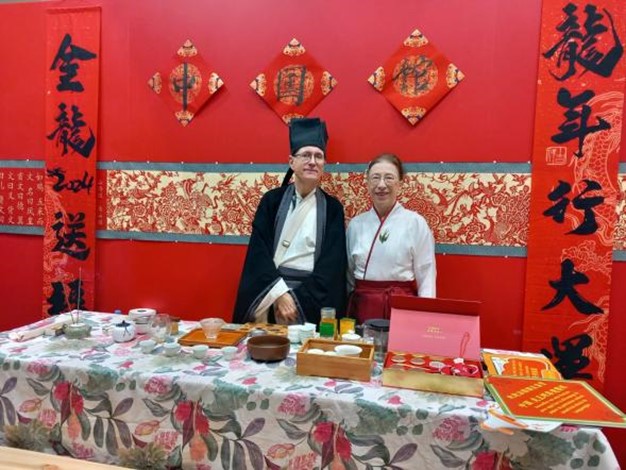
Philippe and his wife are participating in Boyan's activities dressed in Hanfu.
It's not just older members who are drawn to Hanfu. Solange Peron, a student of Chinese Studies and International Relations at National Institute for Oriental Languages and Civilizations, Paris, joined Boyan two years ago during its Chinese New Year Hanfu parade. She explained that it was Hanfu that sparked her love for Chinese culture.
"When we’re captivated by beautiful clothing, we naturally become curious about its origins. Wearing Hanfu ignited my interest in its history, which led me to explore Chinese culture more deeply,” She said.
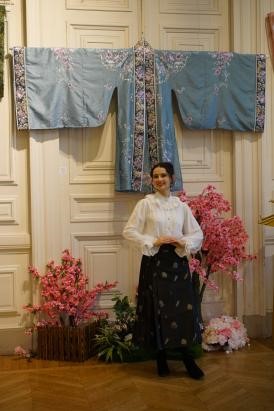
Solange is Visiting the Hanfu exhibition.
In Solange's view, Boyan's events have made traditional Chinese culture more accessible to the French public. Whether it's French people with little knowledge of Chinese culture or overseas Chinese not deeply connected to their heritage, Boyan’s promotion of Chinese culture resonates with both.
Solange believes Boyan has truly brought traditional culture to life. Every time I participate, it feels like stepping back in time—it’s magical, she said. It helps Chinese people reconnect with their history and gives the French a deeper appreciation of China’s cultural heritage. It’s a beautiful mission to be part of.
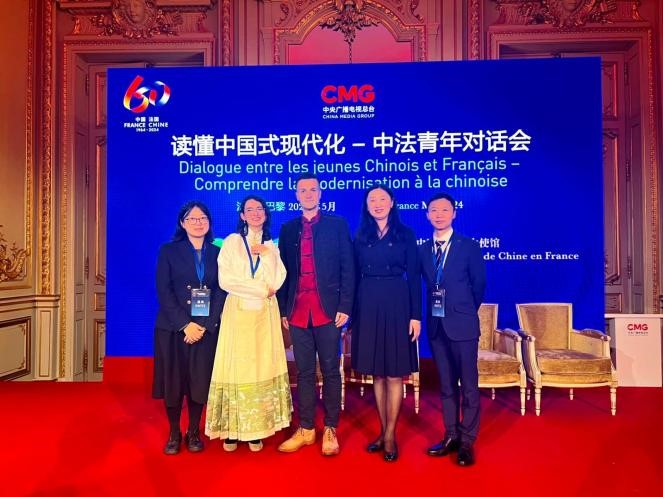
Solange is participating in the China-France Youth Dialogue.
The Beauty of Hanfu Amid Financial Struggles
It’s not just French members like Solange who are captivated by Hanfu; many Chinese members are drawn to Boyan for the same reason.
Xie, now in her forties, candidly admitted that it was the sheer beauty of Hanfu that motivated her to join. While waiting backstage during performances, she seizes every free moment to pose in signature dance moves, letting photographers capture her in Hanfu.
Her teammate, Qi Momo, also a Hanfu enthusiast, joined the association after being captivated by Boyan’s Hanfu photos on social media.
According to Zhong, Boyan owns about 1,000 sets of Hanfu, which are stored in two rented warehouses.
Both Xie and Qi are avid collectors of Hanfu, paying close attention to design and historical accuracy. "For casual wear or regular performances, the style can be flexible, but for important events, it has to be historically correct,” Xie said.
For this commercial performance, they chose the cheapest Hanfu available from Chinese online stores. Despite the lower quality of the design and material, the total cost, including headpieces and accessories, still reached 600-700 yuan per set after shipping to France.
Due to the association’s financial strain, performers receive only a small payment for commercial shows, and they have to cover the upfront cost of costumes themselves. Xie noted that beyond regular classes, there’s no longer enough funding to rent space for extra dance rehearsals.
"The association faces financial challenges almost daily,” said Zhong. "As a non-profit, we can’t generate much income, and at our worst, I’ve barely been able to pay the rent.”
"The annual membership fee is just 25 euros, allowing members to join major events and learn traditional arts like Kunqu opera and classical dance, but it’s far from enough to cover Boyan’s significant operational costs,” she said.
With frequent large-scale events, the expenses are huge. "We cover everything—guest fees, volunteer meals, venue rentals, logistics, insurance, and transportation costs, even banners and posters. For a non-profit, it’s a heavy burden,” Zhong explained.
"When financial crises hit, I’ve had to dip into my own pocket to keep the association running,” she admitted.
Despite these challenges, Boyan has yet to find a solution to its financial struggles. The French government helps by offering venues, and corporate sponsors contribute some funding, but this only eases part of the burden.
"While venue costs are covered, other expenses still weigh us down,” Zhong said.
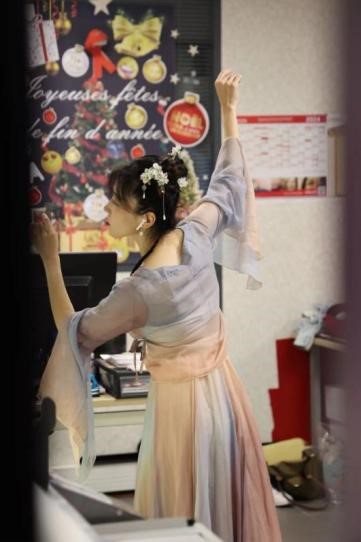
Qi Momo is reviewing her dance moves in the staff office before taking the stage.
"We’re not in this for the money—it’s all about passion,” Xie said. To cut costume costs, they make the most of their performances. Xie explained that when clients like Carrefour request two dances, they send videos of past performances and suggest a mix, such as pairing an energetic dance with a more graceful one. "Since we’ve already invested in the costumes, we work hard to promote the performances and recoup the costs,” she said.
When Zhong first founded the association, Hanfu culture in China was still in its early stages. She believes the Hanfu revival began during the 2003 APEC summit when Chinese leaders wore Tang suit, a modernized outfit inspired by the Qing Dynasty's mandarin jacket, featuring a stand-up collar and Western tailoring techniques.
"People then realized that our core identity is rooted in Han civilization. We are Han people (the ethnic majority in China), so we should be wearing Hanfu (fu means clothing),” Zhong said, considering herself among the first wave of Hanfu revivalists. "In the beginning, Hanfu was seen as something for young people to play dress-up with, but our generation saw it as something worthy of revival and reinvention.”
After earning her PhD in Industrial Engineering, Zhong became a company representative in France. However, as Boyan grew, she said, "Running the association became as demanding as a full-time job. There’s barely time to rest, and almost every day requires a decision.” To manage the growing workload, she reduced her job to part-time, dedicating more time and energy to the association.
Zhong sees running a large non-profit as a true labor of love, requiring a careful balance of time, energy, and life commitments. It all comes down to having a sense of mission and responsibility, she said. Ultimately, it’s about whether you believe in reviving and promoting Chinese culture abroad. If you think it’s worth it, that’s what drives you.
People only give you the chance to spread Chinese culture when they recognize its value and see that you’re doing it well, She said.
Zhong noted that over time, many of the founding members have gradually stepped back from their core roles. A lot of people are still with the group, but they’re less active now, feeling they have other priorities. They still support us and join events occasionally, but they’re no longer the driving force.
This is natural, she said. It’s the way of life—some will move on, but there will always be those who stay committed.
Jiao Junpeng, Student at School of Journalism and Communications,SISU
Lu Zhiyi, Student at School of Journalism and Communications,SISU

 |Hongkou Campus|550 Dalian Road (W), Shanghai 200083, China |Songjiang Campus|1550 Wenxiang Road, Shanghai 201620, China
|Hongkou Campus|550 Dalian Road (W), Shanghai 200083, China |Songjiang Campus|1550 Wenxiang Road, Shanghai 201620, China